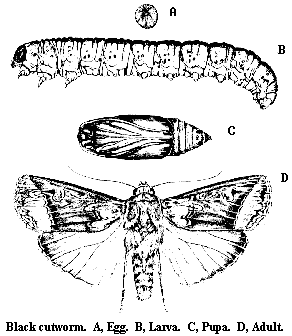Identification
Black cutworm – Agrotis ipsolon (Hufnagel), Noctuidae, Lepidoptera
Adult – The moth is characterized by long, narrow, usually dark forewings which are pale near the tips. There are three black dashes on each forewing. Hind wings are white with dark veins and broad, dark, indefinite margins. The wingspan varies from 38 to 51 mm.
Egg – The egg is white, round, and about 0.5 mm in diameter.
Larva – There are six instars ranging from 4 to 46 mm in length. Above the spiracles, the larva is basically one color, varying from light gray to nearly black. The spiracles are distinctly black. When disturbed, the larva curls up.
Pupa – The brown pupa is about 17 to 22 mm long, with distinct mouthparts and antennae.
Recommendations
Cutworms damage seedling soybeans by cutting the stem just below the cotyledons. These light gray to almost black caterpillars (from 3⁄4 to 11⁄2 inches long) commonly occur in soybean fields, especially no-tillage fields, but rarely kill enough seedlings to affect yield. However, occasionally fields may suffer enough damage to warrant treatment, if discovered in time. If cutworms are not discovered early enough, replanting may be necessary. Before replanting, it is a good idea to examine the field for the continued presence of cutworms and, if high numbers are present, treat the affected area when the replanted seedlings emerge. During daylight hours cutworms hide within the ground or under surface trash.
Economic Threshold
There is no established threshold for cutworm, especially near field edges or in reduced tillage situations. Soybean in the vegetative stages tolerates foliage feeding well, with little to no yield loss measureable up to, and possibly above, 50% defoliation (Thomas et al. 1974). However, cutworms can reduce stands and treatments may be needed in severe situations. Only treat if the pest is present. Try to keep plant populations around 120,000 plants / acre for soybean planted in May, 150,000 plants/acre for soybean planted in June, and 170,000 plants / acre for soybeans planted in July.
Distribution
The black cutworm is a widespread species which can be found from southern Canada throughout the United States, Mexico, and South America. Each year in North Carolina, infested fields occur from the coast to the Tennessee state line. The threat of an infestation appears to be greatest in no-till or weedy corn fields, especially in poorly drained areas.
Host Plants
The black cutworm feeds on a wide range of field and garden crops. Corn and tobacco are two of its preferred crops. Other known hosts include asparagus, bean, beet, cabbage, castor bean, cotton, grape, lettuce, peanut, pepper, potato, radish, soybean, spinach, squash, strawberry and tomato.
Damage
Black cutworms are among the most destructive of all cutworms. The larvae sever plants from roots near the soil line; usually no other feeding damage is present. Many larvae move from plant to plant on successive nights, while some stay to feed on the roots and underground stems of cut plants.
Life History
Little is known about the biology of this pest in North Carolina, but in Tennessee there are four generations annually. Moths of the first or overwintering generation emerges between the middle of March and the first of May. They mature about the middle of May. Second generation moths emerge from the latter part of May to the middle of July. Third generation moths emerge between the middle of July and the last of August. Fourth generation moths make their appearance near the first of September and continue to emerge into December; they produce the overwintering generation. A similar seasonal history probably occurs in North Carolina, where the majority of this pest population overwinters as pupae, though a few overwinter as larvae.
Between 5 and 11 days after emergence, each female begins to deposit about 1,300 eggs in clusters of 1 to 30. Most eggs are laid on low, densely growing plants like chickweed, curly dock, and mustard; corn and soybeans are among the least attractive oviposition hosts. The egg stage lasts 3 to 16 days, depending upon the temperature. These cutworms prefer moist soil where they are usually found in tunnels 8 to 10 cm beneath the surface. The destructive larval stage varies in duration from 3 weeks (or slightly more) in July to over 4 weeks in September. The July-to-August pupal stage lasts about 2 weeks for early pupae; later ones require as much as 8 or 9 weeks.
References
Thomas, G.D., C.M. Ignoffo, K.D. Biever, and D.B. Smith. 1974. Influence of defoliation and depodding on yield of soybeans. J. Econ. Entomol. 67: 683-685.
Publication date: March 17, 2020
N.C. Cooperative Extension prohibits discrimination and harassment regardless of age, color, disability, family and marital status, gender identity, national origin, political beliefs, race, religion, sex (including pregnancy), sexual orientation and veteran status.



